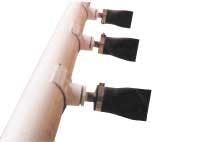Organic Wastewater Treatment News
Poultry Plant Upgrades Wastewater System
Poultry processing plants discharge highly variable effluent high in fats, oils and grease that can prove difficult to treat.
One poultry plant recently chose the Kaldnes Moving Bed Biofilm Reactor (MBBR) to handle the high BOD concentration and large variations in flow. Wastewater enters a tank to equalize the intermittent flows.
The MBBR process consists of thousands of tiny, polyethylene biofilm elements as a substrate for active bateria. The bouyant elements stay in constant motion throughout the entire volume of the reactor for more uniform and effective treatment. Depending on the system design, effluent is then either clarified (two MBBRs in sequence) or discharged into an existing biological treatment system (single MBBR).
Optimizing Nutrients Doubles Organic Wastewater Treatment Efficiency
In 1998 Del Monte Foods in Mendota, IL, began treating its number one lagoon with a vitamin and nutrient product, Bio Huma Netics' Bio Energizer. After four seasons of continued treatment, over 10.7 million pounds of solids have been destroyed. During that time, Del Monte added 7.6 million pounds of pea, corn, carrot, and lima bean waste to an existing 3.5 million pounds of accumulated sludge mass.
After only 41/2 months of using the nutrient product, the sludge blanket depth in the aerated lagoon was reduced by 20 inches and the sludge mass was cut by 3.2 million pounds - all while lagoons remained on line. The product saved Del Monte hundreds of thousands of dollars in dredging costs. Another plus - effluent water quality also improved. The company continues to use BHN'S products to stay ahead of sludge accumulation.
Adding nutritients results in faster, more complete sludge reduction, improved settleability, better decant, and increased capacity.
Diffusers Eliminate Maintenance Headaches
Entenmann's Bakery uses a solids skimmer to separate solids from its combined sanitary and process wastewater before discharging to the city sewer. The bakery saves money because the city charges less for reduced-solid waste.
The solids skimmer has a rotating manifold with four diffuser spouts to evenly distribute solids. The original design had disk-type valves at the spout outlets five inches below the water surface. The valves continually clogged and required cleaning and readjustment to operate properly.
Plant Manager Tom Smith was frustrated trying to maintain this system. "The valves were totally worthless. I spent too much time cleaning them out," Smith said. "Our wastewater contains a lot of debris. I needed a valve that would self clean."
The bakery decided on small-diameter Tideflex® Diffusers from Red Valve Co., Pittsburgh, PA. The patented "duckbill" design allows the diffusers to open with as little as one inch of inline pressure, while back pressure from the wastewater seals the bill, providing absolute protection against clogging and backflow. The diffusers' resilient elastomer construction is designed to resist wear and abrasion. After nearly one year of service, Smith said, "I'm very happy with my Tideflex valves. I get even flow across my tank-the process is running absolutely perfectly. And, I haven't had to clean them once!"



